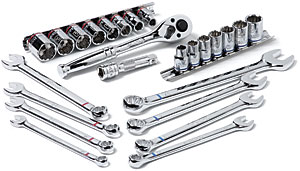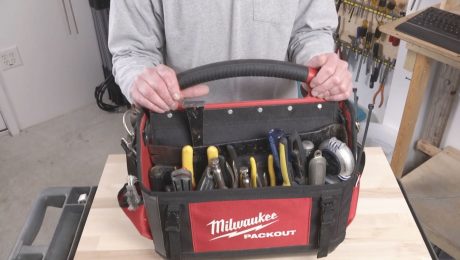DIY Essentials: Homeowner’s Tool Kit
Everything you need to handle emergencies, repairs, and home improvements

If you own a home, an apartment, or a condo, or even if you rent, you need a tool kit. If you’ve gone as far as purchasing this collection of ideas and plans for do-it-yourself-projects, you probably also know that the right tools make the difference between a row of shelves and a string of expletives.
We’ve put together an essential homeowner’s tool kit for everything from emergencies to basic remodeling. Why call a contractor to change a light fixture or paint a room when you can do it yourself and save money?
In cruising local home centers and hardware stores for the tools you see here, we went for brands and models we’ve had good experiences with. The important thing is the type of tool, however, not the make. Quality does count, so it pays to avoid the low end in most cases. You’ll spend close to $1000 for the entire arsenal, but you don’t have to buy it all at once. And you’ll save at least that much every year you own these tools by tackling repairs and upgrades on your own instead of making phone calls (and waiting).
The Core Kit
These are the generalist tools, the ones you’ll use for all sorts of tasks. Some are designed for electrical or plumbing jobs but are much more versatile than that, so we’ve included them in the essential kit.Midsize toolbox, $20-$30
A toolbox that’s roughly 24 in. long will store most of your tools safely but won’t break your back when you have to drag it out of the garage. Look for durable latches and an interior tray.

Bucket organizer, $10-$20
These hanging tool bags fit over a standard 5-gal. bucket and are a perfect companion for your toolbox, because they let you bring a specific set of tools to a specific job. There are lots of outside pockets for hand tools and a big inner space for earmuffs, boxes of screws, extra-long tools, or whatever else you need for the job at hand.

20-oz. rip-claw hammer, $28
For nails, of course, you need a hammer. We recommend a 20-oz. model, which will handle everything from the big nails that are sticking up on your front porch to little brads and staples. The rip-claw design does a better job than a curve claw at pulling big nails.

Utility scissors, $6
A pair of thick utility scissors will cut everything from sheet metal to plastic, including that maddening packaging that most of these tools are sold in.

8-in. molding bar, $10
Your hammer won’t pull out nails that are even slightly below the surface, but this tool will. At one end is a small cat’s paw, which can be driven into the wood with a hammer. At the other end is a flat pry bar.

Nail sets, 3-pack, $6
When installing trim, you want a nail set to drive nail heads slightly below the surface so you can fill the holes with putty for a clean look. Nail sets are available in different sizes so you can match the set to the diameter of the nail.

Utility knife, $6
A utility knife is the go-to tool for cutting all kinds of materials, from cardboard to carpet.

2-ft. level, $25
Whether you are leveling the feet of a washing machine or hanging a picture, you need a level. The 2-ft. size is inexpensive and versatile.

25-ft. tape measure, $23
A 25-ft. tape measure is long enough for almost any job. Choose a tape that’s durable and easy to read, with a wide, stiff blade that reaches out at least 10 ft. without flopping over.

Carpenter’s rafter square, $10
This simple square is designed to be held against a board while you mark 90° and 45° lines. But you also can slide your circular saw against it as a guide to make accurate cuts.

4- or 6-in-1 screwdriver, $6
When it comes to screwdrivers, a good value is a multibit model, which gives you a number of sizes in one tool. This version has two Phillips and two flat sizes. The shaft that holds the bits can also be used as a nut driver.

15-in. carpenter’s saw, $14 or 10-in. pull saw, $20
These small saws are great for quick cuts when you don’t need a power saw. Traditional carpentry saws are durable and easy to control. Japanese-style saws cut on the pull stroke, making it easier to start a cut and avoid binding. They also make finer cuts.


10-in. locking pliers, $13
Locking pliers grab and hold anything while you turn or pull it, such as a nail or a stripped bolt.

10-in. groove-joint pliers, $15
Groove-joint pliers open wide and are especially useful for plumbing jobs.
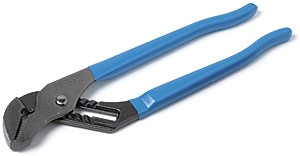
8-in. long-nose pliers, $15
Also called needle-nose pliers, this tool grabs smaller things more precisely and fits where other pliers can’t. The narrow jaws are good for holding small nails and brads while you drive them, and the tool is ideal for wiring jobs—it even includes a wire cutter.

8-in. slip-joint pliers, $7
These standard-issue, two-position pliers are good for everything from twisting wires to squeezing hooks closed to turning nuts and bolts in a pinch.

8-in. adjustable wrench, $13
An adjustable wrench grabs almost anything and saves you from guessing “standard or metric” and then rummaging for an exact fit, as you have to do with the wrench sets below.

Socket and combination wrench set, $100
For a positive grip and much more torque on tough nuts, you need a socket set and a set of combination wrenches in both metric and standard sizes. We recommend a set that has both 1⁄4-in.- and 3⁄8-in.-drive sockets.
Heavy-duty T50 stapler, $18
A T50-size stapler is a construction tool with a host of uses, from attaching insulation and screens to tacking a red flag onto the end of a long board for the trip home from the lumberyard. Get one that is easy to open up and load, and make sure you can squeeze the handle—some are pretty stiff.

Heavy-duty duct tape, $9
When all else fails, reach for the duct tape. It’s not really for air ducts, but the extra-strength type is perfect for all sorts of emergency repairs.
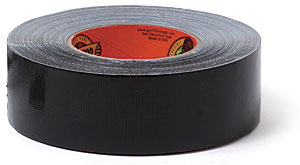
Stud finder, $30
To hang things from walls, such as shelves and cabinets, you need to know where the studs are. A stud finder is the answer. Better-quality models will find both wood and metal studs through both drywall and the plaster-and-lath you’ll find in older homes. Some will also detect live wires (to be avoided).

6-ft. fiberglass stepladder, $70
You might think a step stool with just a couple of steps on it is sufficient, but go for a stepladder. As you climb up to change a smoke detector or light fixture, the ladder gives you something to steady yourself against. We recommend fiberglass. Metal ladders can be dangerous when you are doing electrical work.

Hacksaw, $17
For cutting off bolts, pipes, and other metal things, get a hacksaw. A high-tension model cuts straighter and cleaner than a cheaper saw.

Plumbing Tools
You already have screwdrivers, pliers, and wrenches that work well on plumbing jobs, but you need a few specialists, too. With the following in hand, you’ll be able to handle emergencies, repairs, and fixture installations.
High-capacity plunger, $7
A plunger is your first line of defense against an overflowing toilet or sink. It pays to get a better model with a tapered end that flips in and out. With the end flipped inward, it works on sink and shower drains, and flipped outward, it creates more power and less splash-back on toilets.

Telescoping basin wrench, $23
This tool does just one thing, but without it, you’ll have a harder time changing a faucet. It reaches into the tight space behind a sink to release the nuts that hold the faucet in place and make the water connections.

Teflon tape, $1.50
Teflon tape wraps around threaded pipe to create a water seal. You can get thread sealant in a tube, too, but we like the tape better.

Drain auger, $8
When the plunger won’t work, you need a drain auger (snake). The auger bores into any stubborn clog and clears it, saving you a call to the plumber.

Tools for Electrical Work
Like plumbing jobs, many electrical tasks can be handled with your core tool kit, but once again, you need some specialists.Electrical tape, $3
Electrical tape is great for cord repairs. It comes in handy for many other electrical tasks, too, such as covering exposed terminals on electrical outlets.
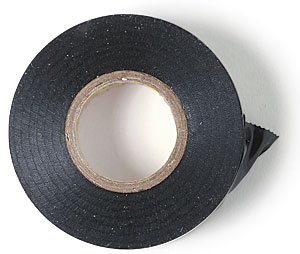
Noncontact voltage tester, $24
A noncontact voltage tester detects the presence of voltage without touching any wire. It’s invaluable for finding live wires. Moving the tester close enough to any hot wire makes it light up. You also can use this tool to check cords and holiday lights for damage.

Voltage tester, $4
Use a voltage tester to confirm that you have the breaker turned off for the circuit you are working on. That is a life-and-death issue. The simplest type has a pair of leads you stick into an outlet or touch to white and black wires to see if they’re live. Advanced models also tell you if you wired the outlet backward.

Wire nuts, $2
Wire nuts join wires, such as when adding a dimmer switch or upgrading a light fixture. A variety pack has the yellow and red sizes you’ll use most.

Wire-stripping pliers, $20
An inexpensive set of wire-stripping pliers is ideal for stripping the ends of wires for splices and connections. Better models include a screw cutter, which trims screws that poke too far into electrical fixtures.

Tools for Painting
You’ll save a stack of cash by doing your own paint jobs. Here’s a collection of tools that will help you do the job right.Roller frames and roller pan, $14
To apply paint quickly and evenly to walls, you need a 9-in. roller frame (buy rollers with the best nap for the job) and a roller pan. We also recommend a 4-in. roller for narrow, flat areas on trim and doors.

Putty knife, $5
Use this tool for scraping off dried paint and filling nail holes with putty. For the latter task, choose a knife with a flexible blade.

Painter’s 5-in-1 tool, $6
This tool has a scraper, with a stiff blade for heavy work, but it does a lot more. It opens paint cans, lets you scrape excess paint off rollers and back into the can, and when wrapped with a rag is the perfect tool for cleaning up wet paint on glass and other surfaces not meant to be painted.

Caulk gun, $3
For sealing against air and water, you need a tube of caulk. To deliver it cleanly and accurately, get a caulk gun. Be sure your gun has a flip-out wire for puncturing a fresh tube and a cutter for widening the tip.

2-in. angled sash brush, $12
For edges, corners, and moldings, you need a good brush. Don’t treat it as a throwaway item. Buy the best brush you can for what you are brushing (oil-based or acrylic paint). It will hold more paint, give smoother results, and last for years with proper cleaning. A 2-in.-wide angled sash brush is probably all you need.

Essential Power Tools
Power tools speed up your work and strip away tedium. They can be dangerous to ears, eyes, and lungs, though, so we’ve included essential safety gear.Drill and driver bits, $10
Get a small set of drill and driver bits. Make sure it includes some long driver bits that will work in an impact driver and that have Phillips, flat, and square-drive tips. A few nut drivers are nice, too.

Cordless-drill and impact-driver kit, $110-$170
Many people keep a cordless drill on hand, and they use it both for drilling and for driving screws. A better option is to buy a kit that includes a 12v drill and an impact driver. You get a standard drill, but you also get the power of an impact driver, which has a vibrating action that makes the biggest screws melt into the hardest wood. An impact driver also drills holes of all sizes. With this kit, you can have one tool set up for drilling and the other ready to drive. The drill chuck takes all your old round-shank drill bits, while the impact driver takes only hex-shank bits.

6-1⁄2- or 7-1⁄4-in. circular saw, $80-$100
You can’t cut everything with a handsaw—well, you can, but you might be there all day. A compact 6-1⁄4-in. circular saw is big enough to cut up 2x lumber or a sheet of plywood quickly. A model with a 7-1⁄4-in. blade is able to cut slightly thicker boards.

5-in. random-orbit sander, $50-$110
A random-orbit sander with hook-and-loop disks can be used to remove loose paint and to smooth rough wood. Spend a bit more here to get faster, smoother sanding action.

30-db. earmuffs, $25
Ear damage is cumulative and irreversible, and the loud bang of a hammer can be as bad as the roar of a circular saw. The most convenient and effective form of protection is simple earmuffs. We recommend a 30-db. noise-reduction rating.

N95-rated dust mask, 2-pack, $7
Wood dust is a carcinogen. For sanding and sawing, you need a good dust mask. Spend a little more for the thicker, multilayered type rated N95 or better, with a vent so your glasses don’t fog. You can use these masks many times over.

Safety glasses, $6
Eye damage is instant and devastating, and even if you wear glasses already, safety glasses are a must. They fit your head closely, and they are rated for very high impact.

6-amp jigsaw, $60-$80
Your circular saw and handsaw only make straight cuts. When reality throws you a curve, you need a jigsaw. Look for at least 6 amps of power. You can put a metal-cutting blade in a jigsaw, too, turning it into a fast-action hacksaw.

Asa Christiana, special projects editor at Fine Woodworking, and Patrick McCombe, associate editor at Fine Homebuilding, contributed to this article. Photos by Kelly J. Dunton.
